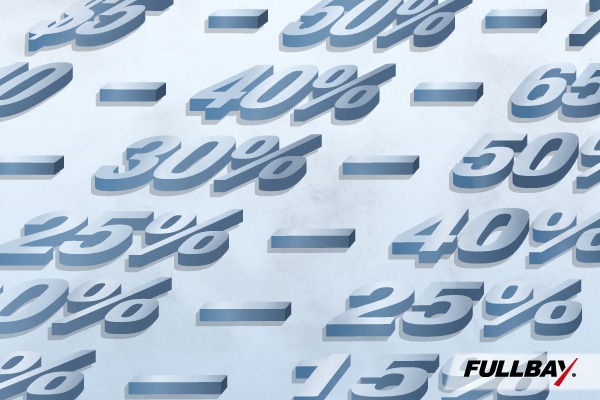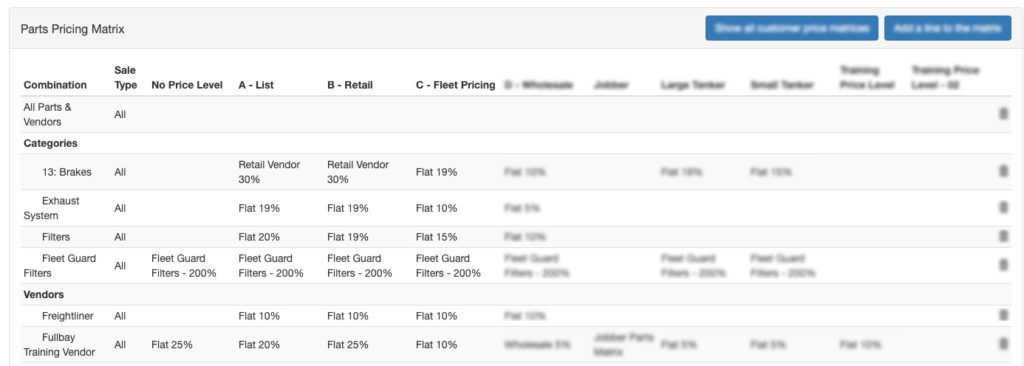Why A Price Matrix Is Just Good Business

A wise man once said, “You have to be deliberate in your pricing.”
That wise man was actually Fullbay Co-Founder and CEO Jacob Findlay, as he explained parts pricing. His overall point was an excellent one: For your shop to stay in business, you need to make a profit. Therefore you need to put some thought into how you price your parts.
It goes further than that, though. You need to be deliberate in all of your pricing, from the cheapest windshield wiper to the most expensive transmission, and everything in between. You need to be deliberate in how you price your labor and your canned jobs.
In short, there are a lot of factors that go into maximizing your revenue and helping your shop turn a profit.
Today we’re going to talk about how a price matrix can help you do all of that and more.
WHAT IS A PRICE MATRIX, ANYWAY?
A price matrix is a pricing structure that gives you some flexibility in how you earn revenue.
First, we’ll give you something easy to compare it to: a flat rate. A flat rate markup is a set percentage or dollar amount that you charge for parts, labor, and so on. It is dependable and generally easy to estimate.
It’s also money left on the table.
Think of a price matrix as pure flexibility. It doesn’t lock you in to a certain percentage or dollar amount. Here’s just some of what you can do with a good price matrix:
- Assign different prices for various parts or vendors
- Create pricing levels for customers
- Pricing based on amount (scales)
Let’s talk about that third bullet for a moment. We have an example we like to encourage: Here at Fullbay, we’re all about tracking PM work. If you have a customer who isn’t totally sold on letting you track their PMs for you (we get it; trust must be earned), you can incentivize them by giving them a break on pricing if you let them track all their PMs.
Parts pricing is another area where a flat rate can end up harming you. Don’t just charge a blanket 20% on every part you sell. You’re buying those parts for different prices; what you sell them for should vary, too. A comprehensive price matrix lets you apply tiered markups that gradually ratchet down as the original part price goes up. For example, if you purchased a part for $1, you’ll want to mark that up by 100% (and charge $2). But if you purchased a part that’s $5,000, you might only want to mark it up by 15%. That’s still a $750 markup and a profit for you.
You can add more layers if you like; you might be marking it up 15% for customers with fleets of 15 vehicles or more, or 20% for fleets with 10 vehicles or less.
That’s just scratching on the surface of what a price matrix can do.
THAT’S AMAZING! HOW DO I GET A PRICE MATRIX?
First, you follow the white rabbit…oh, wait. Sorry, wrong matrix.
If you have Excel and a lot of time on your hands, you can build your own highly detailed price matrix. If you have Excel and don’t have a lot of time on your hands, you can build a very basic version. We aren’t going to make your eyes glaze over by detailing how to do this, but we did find this video, which walks you through the process in about 20 minutes (though we make no guarantees regarding how long this will actually take).
Keep in mind that to make a matrix that is truly useful to your shop, you’ll need to build in discounts, customers with special terms, and markups. If you want to add in tiers and layers, you’ll need to do that on your own, too. Every time you change something, you’ll need to update it.
In short, this isn’t a job for the faint-hearted.
ON SECOND THOUGHT, CAN YOU MAKE ONE FOR ME?
Well, Neo, we’re happy to oblige. Our friend Robby in Accounting very graciously put together this simple price matrix that you can download and customize. Be warned, “simple” really does mean simple. This is an extremely basic price matrix that allows you to set a price for part per vendor or customer. That’s it.
You can certainly use it to better understand how a price matrix works, or even as a starting point to building out a more comprehensive version that you’ll eventually use for your shop.
Making an Excel price matrix for yourself puts you firmly in control of everything – but that also means it’s on you to keep it up to date. Because the actual amount you’ll spend on prices fluctuate, your markup options will fluctuate, too. If a product number changes and you don’t update it, you could end up breaking the entire spreadsheet, and then it won’t be any good to you at all.
Don’t break the spreadsheet.
DOES FULLBAY CREATE PRICE MATRICES?

Fullbay’s graduated parts pricing scale
Actually, it does!
If you love noodling around in Excel and can’t wait to dive in to create your own advanced price matrix, then we’re proud of you. Go for it. Please, show us how it looks.
If you’d rather spend your time working on actual repairs and running your shop instead of fussing with Excel, though, Fullbay has your back. It lets you create tiers and layers right there in the app, and saves them automatically. You won’t need to look at dozens of different things or make adjustments to cells to give a customer a quote. The final price will just be there, right on the screen, ready for you to charge. And if you end up making a change, the app will remember it for next time.

Check out Fullbay’s parts pricing matrix
If you’d like to actually see the Fullbay price matrix in action, head to minute 32 of this webinar– Jacob and Fullbay COO Chris O’Brien walk you through some of its benefits.
Are you ready to increase your efficiency and your shop’s revenue? Or would you just like to know more about Fullbay’s other benefits? Hit us up for a free demo – we’d love to talk to you!

